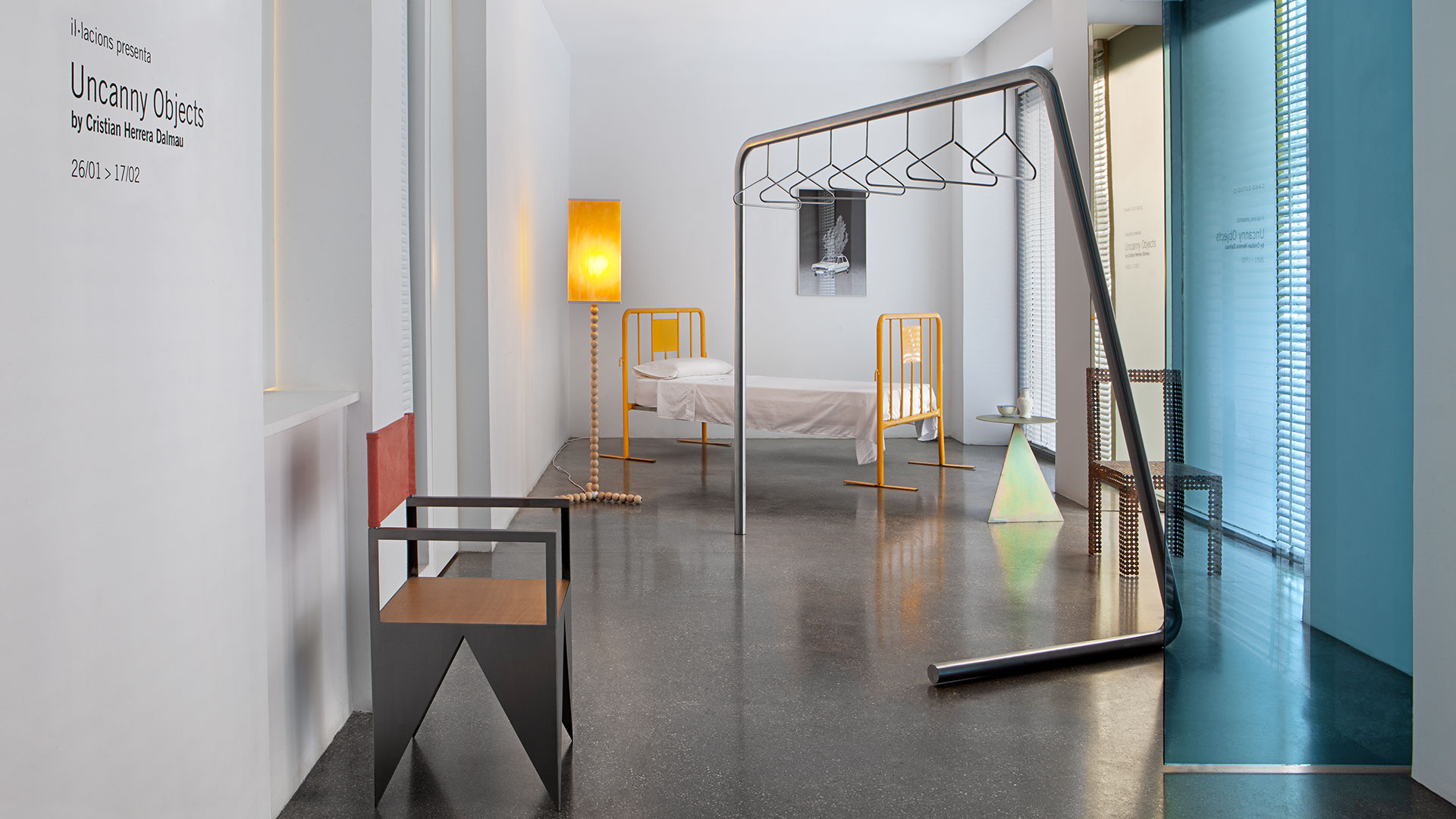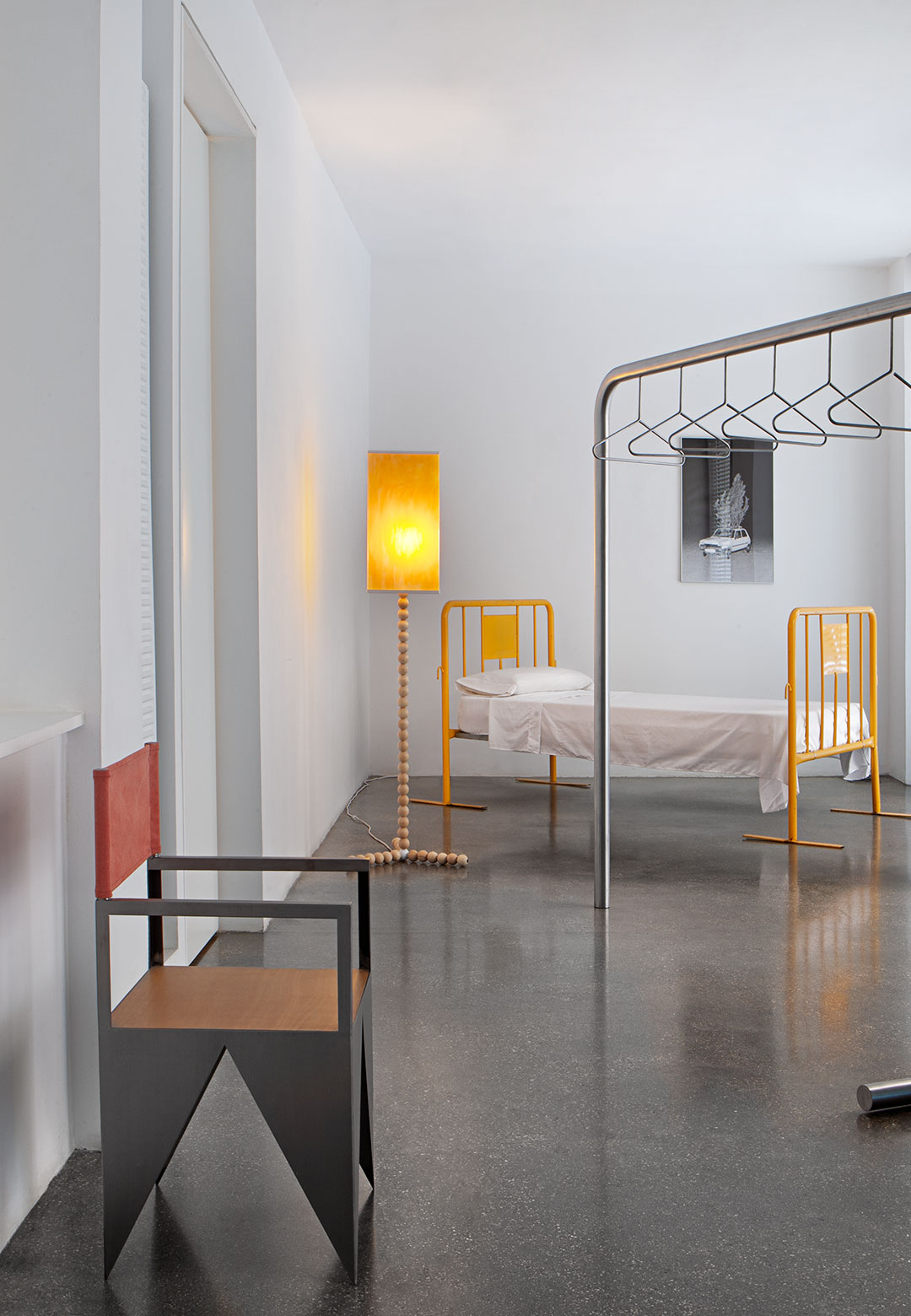For many, art and design, beyond being means of uninhibited expression, are also manifestations of what they would like to see more of in the world, or how they perceive it. What creators conceive speaks of their propensities, thoughts, likes and dislikes more than words ever will, making their oeuvre a fairly apt glimpse into their headspace. Design, for long, has rested safely on and catered to two of its fundamental pillars, form and function—their varying synergies and dynamics culminating into an extensive spectrum. A coterie of designers tread an unconventional path and yield a new stratum, pursuing visuals that make you uneasy and forms that swerve from their original purpose—uncanny vessels of experiences which do not aim to please, at least not tritely.
In the bustling capital city of Spain, Madrid, Il·lacions Gallery platforms the unusual creative vocabulary of Barcelona-based artist Cristian Herrera Dalmau. Titled Uncanny Objects by Cristian Herrera Dalmau, the exhibition, a part of the OFF section of the Madrid Design Festival, will be on display until February 17, 2023, at Espacio Sin Título de Cano Estudio. For the showcase, the creator devises a constellation of objects and furniture designs that, due to their process conceptualisation, sway from their intended purposes. The exhibition comprises seven unique pieces—table designs, chair designs, a table lamp, a bed and a hanger—in which iron is the primary material and speech its raison d’être. “The objects of this exhibition are born with the premise of containing, within the form, experiences and thoughts that have arisen during my personal and professional development and within the making, transcendental and mundane memories in equal parts,” says Dalmau.
Objects as a language and action as a message
Dalmau’s body of work speaks of his roles as an artist and a designer, and how the two blend together such that it is not possible to know where one begins and the other ends. This expedition began during his studies in fine arts when he learned to work with iron and other materials, such as wood and stone. “Before starting out as an independent designer, I was a visual artist. I found in the world of design a space for practical ease, free from the ties of theoretical and prosaic justification imposed by art institutions,” shares the Spanish artist. His explorations of furniture design and creation of other objects unfolded in tandem with his artistic production on performance and video installation; he documented actions where objects, manufactured specifically for each occasion, were activated, and subsequently presented in the exhibition space. This duality soon became the crux of his work ensconced at the intersection of the subject and the object. His explorations, through a variety of methods, establish possible ties between design and art, interpreting objects as a language and action as a message.
Of thoughts, memories, and experiences
In all of Dalmau’s peculiar designs, there lie traces of personal and professional experiences, fragments of his travels across different countries, and remnants of the journeys of bringing a piece to life. The evolution and execution are generators of meaning and declarations, which emphasise the conditional link between words and objects. The Difficult Table, for instance, is a side table named after the unresolved struggle of the furniture designer to achieve an iridescent finish for the piece. The allurement of the bichromated iron is sullied when varnished in every possible way; the indomitable passion of the artist propels him forward to find the optimal solution. Until then, this arresting geometrical varnished table design remains a diamond in the rough.
In the Silla Calderilla, or ‘spare change chair,’ every 5-cent coin that ended up in the designer’s pocket and he hoarded for years, brings to fruition a functional object of a rather discursive character. The materiality of the chair design alludes to the materialistic mannerisms of the subject—unearthing the ultimate aim to build a fortune through the accumulation of loose change. Since, welding all the collected coins together yielded only a single chair leg, the process of completion of the entire composition consumed 1,600 5-cent coins. For a silhouette that exudes certain fragility, as though it would crumble into a heap of pennies under the slightest pressure, the chair can surprisingly withstand up to 80 kilograms. “The Habana table, for example, was an essay I did when I returned from Cuba. Havana is a city that has stopped in time and an assortment of Deco-influenced buildings, with which I deeply connected on a stylistic level, they captivated me by the mysteries of their ornamentation,” the designer explains.
Labyrinths, iridescence and sharp character: generating meaning through form
The zig-zag pattern is a recurring element across Dalmau’s oeuvre, something that he says has to do with the idea of labyrinths. Sharing his admiration for labyrinths, the artist says, “It is a pilgrimage; an introspective path of loss and reunion, through which the individual transcends his original condition.” This fondness informs the intention of some pieces, such as the Online Hanger where the challenge was to solve the shape of the elements in a single line—the origin of its name. If the line drawn by the structure of the coat rack happened to be straight instead of sinuous, it would fail to stand upright and not enjoy self-portability. “That is ultimately the essence of the idea of the classic labyrinth: the virtue is a path without shortcuts,” he explains. This piece, defined by a meandering line, is created from scraps of steel that Dalmau amassed over the years.
Other pieces exhibited in Madrid include the Director’s Chair that catches the eye owing to its pointed legs, inferring the sharp and cutting character of any director of a discipline. The Fency Bed, on the other hand, is an artwork that comes from an exercise that Dalmau enjoys, which is borrowing work materials from the street to create urban furniture that expands the limits of the domestic sphere to the city. “Like the piece Bunkbed Scaffolding—on which I slept during the first year my space was being renovated—the Fency Bed is an element of a residential character designed to bring the idea of ‘comfort’ closer to those people who, either by circumstances beyond their control or by choice, have decided to inhabit public spaces,” explains Dalmau.
Reaching conclusions (or not) even after ceasing the action
Through his thought-provoking work, the artist expresses his strong belief that what is done, has a purpose or a meaning. But this significance can be achieved in two opposite ways of progressing: the inductive and the deductive. “The inductive is the hegemonic current in the current artistic context and defends a praxis that anticipates the conclusion to the execution, that is to say, that one must know what is done before doing it,” Dalmau notes. “The second, the deductive, is what I defend,” he adds. The deductive way deems action as a means of simultaneous observation and contemplates the possibility of reaching conclusions (or not) even after the action terminates.
“This exhibition is the result of an intuitive combination of pieces made at different times and places that, in the best of cases, build a shared meaning resulting from a formal dialogue between the parties,” states Dalmau. The crisp metallic assemblies withhold elaborate narratives. The zig-zag lines emulate Aztec Fretwork and labyrinthine Deco ornamentation while strange forms that instigate psychological responses by epitomising psyches. Iridescent finishes recall artists' tendencies to establish illusion by employing little-known materials, akin to the history of hegemony of elites preserved by guarding materials such as gold, silver and copper from laymen. Objects come to life through things lying around the house or in the workshop, thereby avoiding having to buy additional materials—mundane materials that somehow create an aura of mystery. The pieces that adorn the exhibition space are just words in a language that the artist says he will never fully master—an uncanny language onlookers fancy but never entirely discern.
Uncanny Objects by Cristian Herrera Dalmau is presented by Il·lacions Gallery from January 26 to February 17, 2023, within the OFF section of the Madrid Design Festival in the Espacio Sin Título de Cano Estudio.





 Sign in with email
Sign in with email










What do you think?